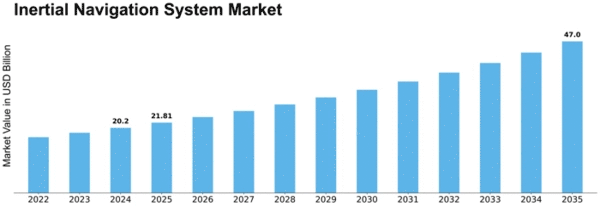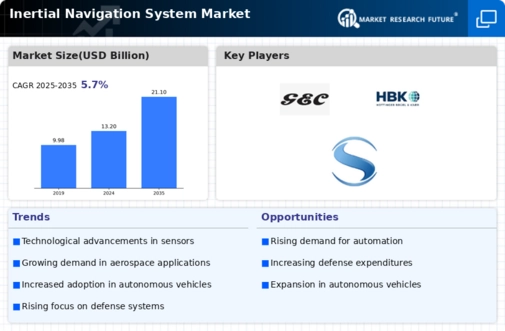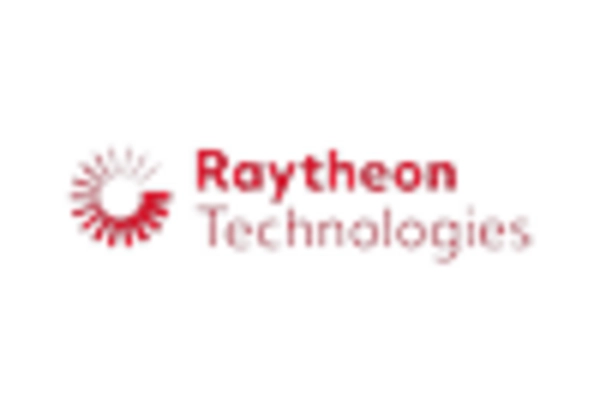-
Executive Summary
-
Market Attractiveness Analysis
- Global Inertial Navigation System Market, by Component
- Global Inertial Navigation System Market, by Technology
- Global Inertial Navigation System Market, by Grade
- Global Inertial Navigation System Market, by Application
- Global Inertial Navigation System Market, by Region
-
Market Introduction
-
Market Definition
-
Scope of the Study
-
Market Structure
-
Key Buying Criteria
-
Market Factor Indicator Analysis
-
Research Methodology
-
Research Process
-
Primary Research
-
Secondary Research
-
Market Size Estimation
-
Forecast Model
-
List of Assumptions
-
Market Insights
-
Market Dynamics
-
Introduction
-
Drivers
- Increasing Demand for New Aircraft
- Changing Nature of Warfare
- Increasing Demand for Accurate Navigation Systems
- Drivers Impact Analysis
-
Restraints
- Operational Complexity
- Restraint Impact Analysis
-
Opportunities
- Technological Advancements in INS
- Development of Autonomous Vehicles
-
Market/Technological Trends
-
Patent Trends
-
Regulatory Landscape/Standards
-
Market Factor Analysis
-
Value Chain/Supply Chain Analysis
- R&D
- Manufacturing
- Distribution & Sales
- Post-Sales Monitoring
-
Porter’s Five Forces Analysis
- Threat of New Entrants
- Bargaining Power of Buyers
- Threat of Substitutes
- Segment Rivalry
- Bargaining Power of Supplies
-
Global Inertial Navigation System Market, by Component
-
Introduction
-
Accelerometers
-
Gyroscopes
-
Magnetometer
-
Inertial Measurement Units (IMUs)
-
Attitude Heading and Reference Systems
-
Other Components
-
Global Inertial Navigation System Market, by Technology
-
Introduction
-
Mechanical Gyro
-
Fiber Optics Gyro
-
Ring Laser Gyro
-
Microelectromechanical Systems (MEMS) Gyro
-
Others
-
Global Inertial Navigation System Market, by Grade
-
Introduction
-
Marine Grade
-
Navigation Grade
-
Military Strategic Grade
-
Space Grade
-
Commercial Grade
-
Global Inertial Navigation System Market, by Application
-
Introduction
-
Aircraft
-
Space Launch Vehicles
-
Missiles
-
Marine
-
Military Armored Vehicles
-
Unmanned Aerial Vehicles (UAVs)
-
Unmanned Ground Vehicles (UGVs)
-
Unmanned Marine Vehicles (UMVs)
-
Global Inertial Navigation System Market, by Region
-
Introduction
-
North America
- US
- Canada
-
Europe
- UK
- Germany
- France
- Italy
- Rest of Europe
-
Asia-Pacific
- China
- Japan
- India
- Australia
- Rest of Asia-Pacific
-
Middle East & Africa
- Saudi Arabia
- UAE
- Rest of Middle East & Africa
-
Latin America
- Brazil
- Rest of Latin America
-
Competitive Landscape
-
Competitive Overview
-
Competitor Dashboard
-
Major Growth Key Strategies in the Global Inertial Navigation System Market
-
Competitive Benchmarking
-
Market Share Analysis
-
Leading Player in terms of the Number of Developments in the Global Inertial Navigation System Market
-
Key Developments & Growth Strategies
- New Product Launch/Service Technology
- Merger & Acquisition
- Joint Ventures
-
Company Profiles
-
Key Market Players
- General Electric Company
- Gladiator Technologies Inc.
- Honeywell International Inc.
- Lord Microstrain
- Northrop Grumman Corporation
- Safran Electronics & Defense
- Teledyne Technologies Inc.
- Thales Group
- Trimble Navigation Ltd.
- United Technologies Corporation
- Vectornav Technologies LLC
-
(Company overview, financial updates, products & service offered, key developments, SWOT analysis, and key strategies to be provided for all the listed companies)
-
Appendix
-
References
-
Related Reports
-
List of Abbreviation
-
List of Tables
-
LIST OF ASSUMPTIONS
-
MAJOR PATENTS GRANTED FOR INERTIAL NAVIGATION SYSTEM (15 MAY 2010–15 MAY 2020)
-
COMPONENT: GLOBAL INERTIAL NAVIGATION SYSTEM MARKET, 2020–2030 (USD MILLION)
-
TECHNOLOGY: GLOBAL INERTIAL NAVIGATION SYSTEM MARKET, 2020–2030 (USD MILLION)
-
GRADE: GLOBAL INERTIAL NAVIGATION SYSTEM MARKET, 2020–2030 (USD MILLION)
-
APPLICATION: GLOBAL INERTIAL NAVIGATION SYSTEM MARKET, 2020–2030 (USD MILLION)
-
GLOBAL INERTIAL NAVIGATION SYSTEM MARKET, BY REGION, 2020–2030 (USD MILLION)
-
NORTH AMERICA: INERTIAL NAVIGATION SYSTEM MARKET, BY COUNTRY, 2020–2030 (USD MILLION)
-
NORTH AMERICA: INERTIAL NAVIGATION SYSTEM MARKET, BY COMPONENT, 2020–2030 (USD MILLION)
-
NORTH AMERICA: INERTIAL NAVIGATION SYSTEM MARKET, BY TECHNOLOGY, 2020–2030 (USD MILLION)
-
NORTH AMERICA: INERTIAL NAVIGATION SYSTEM MARKET, BY GRADE, 2020–2030 (USD MILLION)
-
NORTH AMERICA: INERTIAL NAVIGATION SYSTEM MARKET, BY APPLICATION, 2020–2030 (USD MILLION)
-
US: INERTIAL NAVIGATION SYSTEM MARKET, BY COMPONENT, 2020–2030 (USD MILLION)
-
US: INERTIAL NAVIGATION SYSTEM MARKET, BY TECHNOLOGY, 2020–2030 (USD MILLION)
-
US: INERTIAL NAVIGATION SYSTEM MARKET, BY GRADE, 2020–2030 (USD MILLION)
-
US: INERTIAL NAVIGATION SYSTEM MARKET, BY APPLICATION, 2020–2030 (USD MILLION)
-
CANADA: INERTIAL NAVIGATION SYSTEM MARKET, BY COMPONENT, 2020–2030 (USD MILLION)
-
CANADA: INERTIAL NAVIGATION SYSTEM MARKET, BY TECHNOLOGY, 2020–2030 (USD MILLION)
-
CANADA: INERTIAL NAVIGATION SYSTEM MARKET, BY GRADE, 2020–2030 (USD MILLION)
-
CANADA: INERTIAL NAVIGATION SYSTEM MARKET, BY APPLICATION, 2020–2030 (USD MILLION)
-
EUROPE: INERTIAL NAVIGATION SYSTEM MARKET, BY COUNTRY, 2020–2030 (USD MILLION)
-
EUROPE: INERTIAL NAVIGATION SYSTEM MARKET, BY COMPONENT, 2020–2030 (USD MILLION)
-
EUROPE: INERTIAL NAVIGATION SYSTEM MARKET, BY TECHNOLOGY, 2020–2030 (USD MILLION)
-
EUROPE: INERTIAL NAVIGATION SYSTEM MARKET, BY GRADE, 2020–2030 (USD MILLION)
-
EUROPE: INERTIAL NAVIGATION SYSTEM MARKET, BY APPLICATION, 2020–2030 (USD MILLION)
-
UK: INERTIAL NAVIGATION SYSTEM MARKET, BY COMPONENT, 2020–2030 (USD MILLION)
-
UK: INERTIAL NAVIGATION SYSTEM MARKET, BY TECHNOLOGY, 2020–2030 (USD MILLION)
-
UK: INERTIAL NAVIGATION SYSTEM MARKET, BY GRADE, 2020–2030 (USD MILLION)
-
UK: INERTIAL NAVIGATION SYSTEM MARKET, BY APPLICATION, 2020–2030 (USD MILLION)
-
GERMANY: INERTIAL NAVIGATION SYSTEM MARKET, BY COMPONENT, 2020–2030 (USD MILLION)
-
GERMANY: INERTIAL NAVIGATION SYSTEM MARKET, BY TECHNOLOGY, 2020–2030 (USD MILLION)
-
GERMANY: INERTIAL NAVIGATION SYSTEM MARKET, BY GRADE, 2020–2030 (USD MILLION)
-
GERMANY: INERTIAL NAVIGATION SYSTEM MARKET, BY APPLICATION, 2020–2030 (USD MILLION)
-
FRANCE: INERTIAL NAVIGATION SYSTEM MARKET, BY COMPONENT, 2020–2030 (USD MILLION)
-
FRANCE: INERTIAL NAVIGATION SYSTEM MARKET, BY TECHNOLOGY, 2020–2030 (USD MILLION)
-
FRANCE: INERTIAL NAVIGATION SYSTEM MARKET, BY GRADE, 2020–2030 (USD MILLION)
-
FRANCE: INERTIAL NAVIGATION SYSTEM MARKET, BY APPLICATION, 2020–2030 (USD MILLION)
-
ITALY: INERTIAL NAVIGATION SYSTEM MARKET, BY COMPONENT, 2020–2030 (USD MILLION)
-
ITALY: INERTIAL NAVIGATION SYSTEM MARKET, BY TECHNOLOGY, 2020–2030 (USD MILLION)
-
ITALY: INERTIAL NAVIGATION SYSTEM MARKET, BY GRADE, 2020–2030 (USD MILLION)
-
ITALY: INERTIAL NAVIGATION SYSTEM MARKET, BY APPLICATION, 2020–2030 (USD MILLION)
-
REST OF EUROPE: INERTIAL NAVIGATION SYSTEM MARKET, BY COMPONENT, 2020–2030 (USD MILLION)
-
REST OF EUROPE: INERTIAL NAVIGATION SYSTEM MARKET, BY TECHNOLOGY, 2020–2030 (USD MILLION)
-
REST OF EUROPE: INERTIAL NAVIGATION SYSTEM MARKET, BY GRADE, 2020–2030 (USD MILLION)
-
REST OF EUROPE: INERTIAL NAVIGATION SYSTEM MARKET, BY APPLICATION, 2020–2030 (USD MILLION)
-
ASIA-PACIFIC: INERTIAL NAVIGATION SYSTEM MARKET, BY COUNTRY, 2020–2030 (USD MILLION)
-
ASIA-PACIFIC: INERTIAL NAVIGATION SYSTEM MARKET, BY COMPONENT, 2020–2030 (USD MILLION)
-
ASIA-PACIFIC: INERTIAL NAVIGATION SYSTEM MARKET, BY TECHNOLOGY, 2020–2030 (USD MILLION)
-
ASIA-PACIFIC: INERTIAL NAVIGATION SYSTEM MARKET, BY GRADE, 2020–2030 (USD MILLION)
-
ASIA-PACIFIC: INERTIAL NAVIGATION SYSTEM MARKET, BY APPLICATION, 2020–2030 (USD MILLION)
-
CHINA: INERTIAL NAVIGATION SYSTEM MARKET, BY COMPONENT, 2020–2030 (USD MILLION)
-
CHINA: INERTIAL NAVIGATION SYSTEM MARKET, BY TECHNOLOGY, 2020–2030 (USD MILLION)
-
CHINA: INERTIAL NAVIGATION SYSTEM MARKET, BY GRADE, 2020–2030 (USD MILLION)
-
CHINA: INERTIAL NAVIGATION SYSTEM MARKET, BY APPLICATION, 2020–2030 (USD MILLION)
-
INDIA: INERTIAL NAVIGATION SYSTEM MARKET, BY COMPONENT, 2020–2030 (USD MILLION)
-
INDIA: INERTIAL NAVIGATION SYSTEM MARKET, BY TECHNOLOGY, 2020–2030 (USD MILLION)
-
INDIA: INERTIAL NAVIGATION SYSTEM MARKET, BY GRADE, 2020–2030 (USD MILLION)
-
INDIA: INERTIAL NAVIGATION SYSTEM MARKET, BY APPLICATION, 2020–2030 (USD MILLION)
-
JAPAN: INERTIAL NAVIGATION SYSTEM MARKET, BY COMPONENT, 2020–2030 (USD MILLION)
-
JAPAN: INERTIAL NAVIGATION SYSTEM MARKET, BY TECHNOLOGY, 2020–2030 (USD MILLION)
-
JAPAN: INERTIAL NAVIGATION SYSTEM MARKET, BY GRADE, 2020–2030 (USD MILLION)
-
JAPAN: INERTIAL NAVIGATION SYSTEM MARKET, BY APPLICATION, 2020–2030 (USD MILLION)
-
AUSTRALIA: INERTIAL NAVIGATION SYSTEM MARKET, BY COMPONENT, 2020–2030 (USD MILLION)
-
AUSTRALIA: INERTIAL NAVIGATION SYSTEM MARKET, BY TECHNOLOGY, 2020–2030 (USD MILLION)
-
AUSTRALIA: INERTIAL NAVIGATION SYSTEM MARKET, BY GRADE, 2020–2030 (USD MILLION)
-
AUSTRALIA: INERTIAL NAVIGATION SYSTEM MARKET, BY APPLICATION, 2020–2030 (USD MILLION)
-
REST OF ASIA-PACIFIC: INERTIAL NAVIGATION SYSTEM MARKET, BY COMPONENT, 2020–2030 (USD MILLION)
-
REST OF ASIA-PACIFIC: INERTIAL NAVIGATION SYSTEM MARKET, BY TECHNOLOGY, 2020–2030 (USD MILLION)
-
REST OF ASIA-PACIFIC: INERTIAL NAVIGATION SYSTEM MARKET, BY GRADE, 2020–2030 (USD MILLION)
-
REST OF ASIA-PACIFIC: INERTIAL NAVIGATION SYSTEM MARKET, BY APPLICATION, 2020–2030 (USD MILLION)
-
MIDDLE EAST & AFRICA: INERTIAL NAVIGATION SYSTEM MARKET, BY COUNTRY, 2020–2030 (USD MILLION)
-
MIDDLE EAST & AFRICA: INERTIAL NAVIGATION SYSTEM MARKET, BY COMPONENT, 2020–2030 (USD MILLION)
-
MIDDLE EAST & AFRICA: INERTIAL NAVIGATION SYSTEM MARKET, BY TECHNOLOGY, 2020–2030 (USD MILLION)
-
MIDDLE EAST & AFRICA: INERTIAL NAVIGATION SYSTEM MARKET, BY GRADE, 2020–2030 (USD MILLION)
-
MIDDLE EAST & AFRICA: INERTIAL NAVIGATION SYSTEM MARKET, BY APPLICATION, 2020–2030 (USD MILLION)
-
SAUDI ARABIA: INERTIAL NAVIGATION SYSTEM MARKET, BY COMPONENT, 2020–2030 (USD MILLION)
-
SAUDI ARABIA: INERTIAL NAVIGATION SYSTEM MARKET, BY TECHNOLOGY, 2020–2030 (USD MILLION)
-
SAUDI ARABIA: INERTIAL NAVIGATION SYSTEM MARKET, BY GRADE, 2020–2030 (USD MILLION)
-
SAUDI ARABIA: INERTIAL NAVIGATION SYSTEM MARKET, BY APPLICATION, 2020–2030 (USD MILLION)
-
UAE: INERTIAL NAVIGATION SYSTEM MARKET, BY COMPONENT, 2020–2030 (USD MILLION)
-
UAE: INERTIAL NAVIGATION SYSTEM MARKET, BY TECHNOLOGY, 2020–2030 (USD MILLION)
-
UAE: INERTIAL NAVIGATION SYSTEM MARKET, BY GRADE, 2020–2030 (USD MILLION)
-
UAE: INERTIAL NAVIGATION SYSTEM MARKET, BY APPLICATION, 2020–2030 (USD MILLION)
-
REST OF THE MIDDLE EAST & AFRICA: INERTIAL NAVIGATION SYSTEM MARKET, BY COMPONENT, 2020–2030 (USD MILLION)
-
REST OF THE MIDDLE EAST & AFRICA: INERTIAL NAVIGATION SYSTEM MARKET, BY TECHNOLOGY, 2020–2030 (USD MILLION)
-
REST OF THE MIDDLE EAST & AFRICA: INERTIAL NAVIGATION SYSTEM MARKET, BY GRADE, 2020–2030 (USD MILLION)
-
REST OF THE MIDDLE EAST & AFRICA: INERTIAL NAVIGATION SYSTEM MARKET, BY APPLICATION, 2020–2030 (USD MILLION)
-
LATIN AMERICA: INERTIAL NAVIGATION SYSTEM MARKET, BY COUNTRY, 2020–2030 (USD MILLION)
-
LATIN AMERICA: INERTIAL NAVIGATION SYSTEM MARKET, BY COMPONENT, 2020–2030 (USD MILLION)
-
LATIN AMERICA: INERTIAL NAVIGATION SYSTEM MARKET, BY TECHNOLOGY, 2020–2030 (USD MILLION)
-
LATIN AMERICA: INERTIAL NAVIGATION SYSTEM MARKET, BY GRADE, 2020–2030 (USD MILLION)
-
LATIN AMERICA: INERTIAL NAVIGATION SYSTEM MARKET, BY APPLICATION, 2020–2030 (USD MILLION)
-
BRAZIL: INERTIAL NAVIGATION SYSTEM MARKET, BY COMPONENT, 2020–2030 (USD MILLION)
-
BRAZIL: INERTIAL NAVIGATION SYSTEM MARKET, BY TECHNOLOGY, 2020–2030 (USD MILLION)
-
BRAZIL: INERTIAL NAVIGATION SYSTEM MARKET, BY GRADE, 2020–2030 (USD MILLION)
-
BRAZIL: INERTIAL NAVIGATION SYSTEM MARKET, BY APPLICATION, 2020–2030 (USD MILLION)
-
REST OF LATIN AMERICA: INERTIAL NAVIGATION SYSTEM MARKET, BY COMPONENT, 2020–2030 (USD MILLION)
-
REST OF LATIN AMERICA: INERTIAL NAVIGATION SYSTEM MARKET, BY TECHNOLOGY, 2020–2030 (USD MILLION)
-
REST OF LATIN AMERICA: INERTIAL NAVIGATION SYSTEM MARKET, BY FREQUENCY- BAND, 2020–2030 (USD MILLION)
-
REST OF LATIN AMERICA: INERTIAL NAVIGATION SYSTEM MARKET, BY APPLICATION, 2020–2030 (USD MILLION)
-
THE MOST ACTIVE PLAYERS IN THE GLOBAL INERTIAL NAVIGATION SYSTEM MARKET
-
CONTRACTS AND AGREEMENTS
-
MERGERS AND ACQUISITIONS
-
PRODUCT DEVELOPMENTS
-
EXPANSIONS AND INVESTMENTS
-
JOINT VENTURES AND PARTNERSHIPS
-
-
List of Figures
-
MARKET SYNOPSIS
-
GLOBAL INERTIAL NAVIGATION SYSTEM MARKET: MARKET ATTRACTIVENESS ANALYSIS
-
GLOBAL INERTIAL NAVIGATION SYSTEM MARKET ANALYSIS, BY COMPONENT
-
GLOBAL INERTIAL NAVIGATION SYSTEM MARKET ANALYSIS, BY APPLICATION
-
GLOBAL INERTIAL NAVIGATION SYSTEM MARKET ANALYSIS, BY GRADE
-
GLOBAL INERTIAL NAVIGATION SYSTEM MARKET ANALYSIS, BY APPLICATION
-
GLOBAL INERTIAL NAVIGATION SYSTEM MARKET ANALYSIS, BY REGION
-
GLOBAL INERTIAL NAVIGATION SYSTEM MARKET: MARKET STRUCTURE
-
KEY BUYING CRITERIA FOR INERTIAL NAVIGATION SYSTEM COMPONENTS
-
RESEARCH PROCESS OF MRFR
-
NORTH AMERICA: MARKET SIZE & MARKET SHARE, BY COUNTRY, 2020 VS 2030
-
EUROPE: MARKET SIZE & MARKET SHARE, BY COUNTRY, 2020 VS 2030
-
ASIA-PACIFIC: MARKET SIZE & MARKET SHARE, BY COUNTRY, 2020 VS 2030
-
MIDDLE EAST & AFRICA: MARKET SIZE & MARKET SHARE, BY COUNTRY, 2020 VS 2030
-
LATIN AMERICA: MARKET SIZE & MARKET SHARE, BY REGION, 2020 VS 2030
-
MARKET DYNAMICS OVERVIEW
-
DRIVERS IMPACT ANALYSIS: GLOBAL INERTIAL NAVIGATION SYSTEM MARKET
-
RESTRAINTS IMPACT ANALYSIS: GLOBAL INERTIAL NAVIGATION SYSTEM MARKET
-
PORTER’S FIVE FORCES ANALYSIS OF THE GLOBAL INERTIAL NAVIGATION SYSTEM MARKET
-
SUPPLY CHAIN: GLOBAL INERTIAL NAVIGATION SYSTEM MARKET
-
GLOBAL INERTIAL NAVIGATION SYSTEM MARKET SHARE, BY COMPONENT, 2020 (% SHARE)
-
GLOBAL INERTIAL NAVIGATION SYSTEM MARKET SHARE, BY APPLICATION, 2020 (% SHARE)
-
GLOBAL INERTIAL NAVIGATION SYSTEM MARKET SHARE, BY GRADE, 2020 (% SHARE)
-
GLOBAL INERTIAL NAVIGATION SYSTEM MARKET SHARE, BY REGION, 2020 (% SHARE)
-
NORTH AMERICA: INERTIAL NAVIGATION SYSTEM MARKET SHARE, BY COUNTRY, 2020 (% SHARE)
-
EUROPE: INERTIAL NAVIGATION SYSTEM MARKET SHARE, BY COUNTRY, 2020 (% SHARE)
-
ASIA-PACIFIC: INERTIAL NAVIGATION SYSTEM MARKET SHARE, BY COUNTRY, 2020 (% SHARE)
-
MIDDLE EAST & AFRICA: INERTIAL NAVIGATION SYSTEM MARKET SHARE, BY COUNTRY, 2020 (% SHARE)
-
LATIN AMERICA: INERTIAL NAVIGATION SYSTEM MARKET SHARE, BY COUNTRY, 2020 (% SHARE)
-
COMPETITOR DASHBOARD: GLOBAL INERTIAL NAVIGATION SYSTEM MARKET
-
CAPITAL MARKET RATIO AND FINANCIAL MATRIX
-
CONTRACTS & AGREEMENTS: THE MAJOR STRATEGY ADOPTED BY KEY PLAYERS IN THE GLOBAL INERTIAL NAVIGATION SYSTEM MARKET
-
BENCHMARKING OF MAJOR COMPETITORS
-
MAJOR MANUFACTURERS MARKET SHARE ANALYSIS, 2020


















Leave a Comment